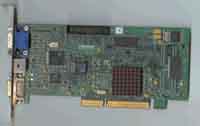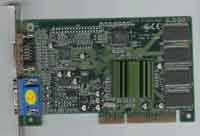It's easy to make a decision on what video card you want to buy in comparison to the difficult time the manufacturers have creating the products you want, while making a profit and remaining competitive. There is a choice, as a manufacturer, that you must make before beginning production on any new video solution: whether you're going to strive to be the absolute best, or be the best in a certain price range. If you pick the former, you're in for a rough ride, as the competitive nature of manufacturers in the video industry will keep you on your toes.
This is the path companies such as 3dfx and NVIDIA have stuck to, and as you can tell by the intense competition that exists between their products (as well as between their users). If you are to choose the latter option, times are a bit less fast paced and competitive, however the challenge is equally as great if not greater. Basically, as a manufacturer looking to produce a low-cost, high-performance video solution, you are placed under the same expectations as the big boys, but you're now limited by cost.
Case in point is the formerly dominant force in the video industry, S3. Originally on top of the game before the 3D revolution in the mid-90's, S3 controlled a large portion of the market simply because they could produce competitive 2D accelerators that performed well, and could be molded to fit virtually any desktop situation. With the dawn of the 3D gaming era, S3, like a number of other former heavy weights such as Matrox and Number Nine, seemingly dropped off the face of the earth. Last year was the return of the former heavy weights to the market and comparatively speaking, they did not achieve the same status that they once held prior to the transition towards standardizing 3D accelerators.
S3's Savage3D, on paper, was a high-end solution capable of winning the elusive title of "Voodoo2-killer," the most sought after champion of 1998. Unfortunately, in practice, the Savage3D turned out to be one of the biggest failures of the industry. While the Savage3D did manage to find its very own niche market with Super7 users as well as some lower end Slot-1 users, the product itself (as well as its drivers) were quite immature and the product never really attained its full potential. Most manufacturers such as Diamond Multimedia dropped their Savage3D based products, leaving a relatively few companies, mostly Taiwanese OEMs, to buy out the remaining Savage3D parts and make low-cost 2D/3D AGP accelerators out of them.
The only big-name to boast a truly reliable Savage3D solution was Hercules, a company whose devotion to quality led them to a discriminating process of hand picking Savage3D chips for their accelerators, which made Hercules' Savage3D boards undoubtedly the best in the industry. But in the grand scheme of things, it would take much more than Hercules, a company much smaller than the Diamonds and Creatives out there to save S3's rear with the Savage3D. What S3 needed was another chance, should the market give them another chance and more importantly, is it worth re-visiting S3 after what they pulled with the Savage3D? Let's find out as AnandTech takes an in-depth look at S3's latest shot at a low-cost, high-performance video-solution.
Enter the Savage4
| This time around, 3dfx isn't the competition, NVIDIA isn't the one to topple, and Matrox isn't the one S3 needs to be guarding their customers from, instead, this time around S3 is looking to be the best they can be, not the best in the market. With the Savage3D, there was much confusion as to what the target audience of the product would be. As a high-performing solution, the Savage3D would offer the most bang for your buck, however the frame rate dreams of the Savage3D ended up being quite disappointing and therefore took it out of the run for the number one spot in the race for the 3D king last year. |
| The Savage4 starts off by boasting a core very similar to the original Savage3D, in actuality, the 0.25-micron core of the Savage3D (one of the first to be implemented in a video accelerator) bears a striking physical resemblance to the Savage4. The core is clocked at a meager, by today's newly set standards, 125MHz, with a memory clock of 125/143MHz, a feature which is up to the manufacturer's discretion. |
The Savage4 builds on the stack of the Savage3D's original features, adding such important features as single-pass multi-texturing and bringing back the old strengths of the Savage3D such as the texture compression that filled so many screen shots last year. As with most other 3D accelerators that are just now hitting the streets, the Savage4 provides compatibility with both AGP 2X and 4X specifications, with the 4X versions of the parts hitting the streets towards the end of the year with Intel's release of the upcoming AGP 4X compliant 820 chipset (aka Camino).
The Savage4 allows for a number of different memory configurations, allowing for manufacturers to custom make their products fit the price and performance needs of their target market. At first, only 16MB and 32MB boards will be seen on the market, however there is always the option of pursuing a cheaper 8MB alternative for OEMs and other such cases where price is a very delicate issue. After discussing the topic with a couple of manufacturers, it seems like the 32MB Savage4 based products won't be too big of a rarity in the low-cost isles at your local computer hardware store.
Also, mimicking the latest from 3dfx and NVIDIA (and soon to be Matrox), the Savage4 also supports the "oh-so-marketable" digital interface for flat panel LCD displays, a feature which will slowly gain popularity and eventually pick up as the desired output port on video cards when digital LCD monitors drop to a more reasonable price point.












0 Comments
View All Comments